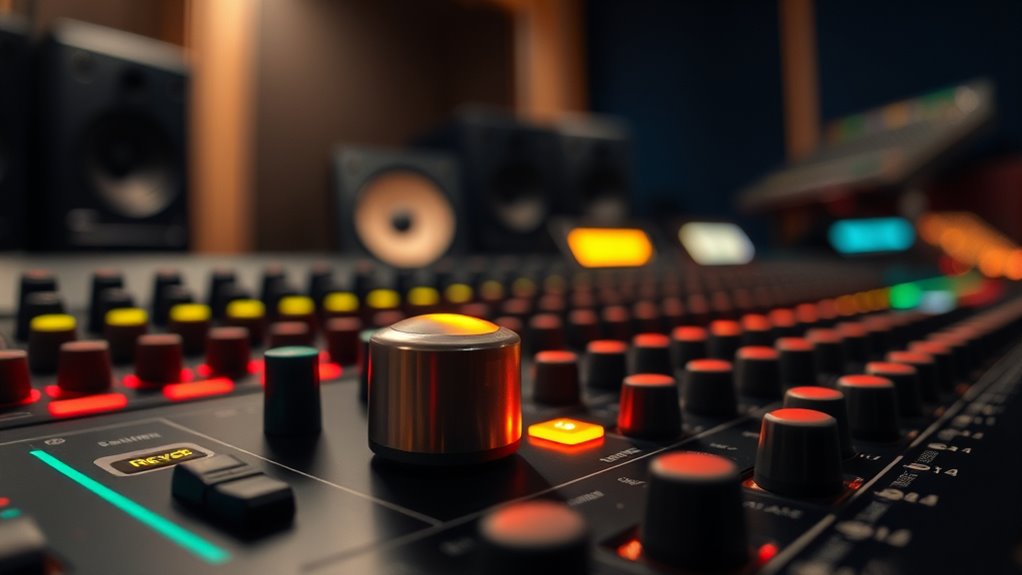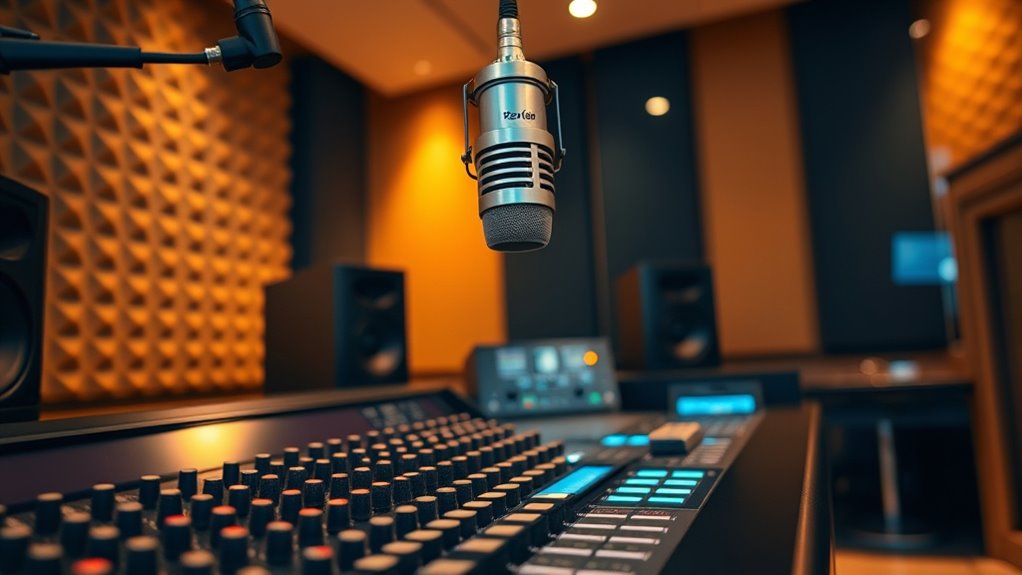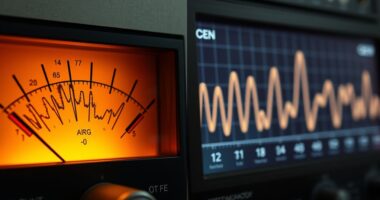To craft depth in your vocals without drowning them, start by choosing the right reverb type and adjusting decay and pre-delay to suit your track’s mood. Keep reverb levels modest and use EQ to remove muddiness and harshness. Control the tail length with gating or compression to maintain clarity. Balancing these settings guarantees your vocals sound spacious yet focused—if you want tips to fine-tune your reverb tails, there’s more to explore below.
Key Takeaways
- Adjust decay time and pre-delay to create spaciousness without overwhelming the vocals.
- Use EQ to carve out muddy or harsh frequencies in reverb tails, maintaining clarity.
- Balance reverb levels carefully to add depth while keeping vocals upfront and intelligible.
- Utilize gating or compression to control excessive reverb tails and prevent clutter.
- Automate reverb parameters across the song to enhance depth selectively without drowning vocals.
Understanding the Role of Reverb Tails in Vocal Mixing

Reverb tails are essential in vocal mixing because they shape the sense of space and depth around the voice. When you add reverb, the tail is the lingering echo that follows the initial sound, giving your vocals a sense of environment. A well-crafted reverb tail can make your vocals feel more natural and immersive, as if they’re performed in a real or imagined space. It helps to blend vocals with other elements and prevents them from sounding flat or disconnected. The length and decay of the tail influence how spacious your mix feels—too long and it may muddy the sound; too short and it might lack ambiance. Understanding how these tails affect perception is key to creating a balanced, engaging vocal sound. Additionally, selecting a projector with high contrast ratios can enhance the clarity and depth of the visual experience, paralleling how proper reverb tails can add dimensionality to audio. Moreover, experimenting with different decay settings can help you fine-tune the sense of space to match your artistic intent. Incorporating appropriate room size parameters can further refine the spatial effects, making your mix more convincing. Recognizing the importance of attention in this process can also improve your overall mixing skills and creativity.
Selecting the Right Reverb Type and Settings

Choosing the right reverb type and settings is essential for achieving a natural and fitting vocal sound. Start by selecting a reverb that complements your track’s style—plate reverb adds brightness, while hall reverb creates spaciousness. Adjust the decay time to match the song’s mood; shorter decays keep vocals clear, longer ones add lushness. Focus on the pre-delay to give vocals space before the reverb kicks in, preventing clutter. Tweak the early reflections to shape the initial sense of space without overwhelming the voice. Use a dry/wet mix that balances reverb presence without drowning the vocals. Remember, subtle adjustments often yield the best results, so listen carefully and refine your settings until the reverb enhances your vocals naturally and effectively. Additionally, understanding reverb tails can help you craft a sense of depth without overpowering the vocal clarity. Paying attention to soundscape elements can further refine how the reverb blends seamlessly into your mix. Incorporating tail length adjustments can also help you control how long the reverb persists, adding to the overall depth. It’s also beneficial to consider professional mixing techniques to ensure your reverb sits well within the overall production.
Techniques for Controlling Reverb Tail Length and Decay

Controlling the tail length and decay of reverb is essential for maintaining clarity and preventing muddiness in your mix. To do this, adjust your reverb’s decay time or pre-delay settings. Shortening decay tightens the reverb, keeping vocals clear. Use gates or compressors to mute the reverb tail when it’s no longer needed. Visualize the reverb tail as:
| Short Tail | Long Tail |
|---|---|
| Crisp, controlled sound | Spacious, enveloping ambiance |
| Quick fade-out | Extended, lingering echo |
| Less clutter, more focus | Can cause muddiness if overdone |
Familiarity with reverb tail control techniques can help you achieve a more polished sound in your mixes. Additionally, understanding how sound decay influences the perception of space can aid in crafting a balanced mix that complements your vocals. Mastering decay time adjustment allows for more precise tailoring of your reverb to fit different musical contexts.
Using EQ to Shape and Clear Reverb Tails

Using EQ is a powerful way to shape and clarify reverb tails, ensuring they enhance your mix without overpowering the main elements. Start by identifying muddy frequencies, typically in the low-mid range (200-500Hz), and cut them gently to prevent a boomy sound. If the reverb sounds harsh or sibilant, reduce high frequencies around 3-8kHz. Boosting the high end slightly can add brightness, but use sparingly. Narrow Q settings help target specific problem areas without affecting the overall reverb. Applying high-pass filters removes unnecessary low-end rumble, keeping the reverb clean and focused. Remember, subtle EQ adjustments make a significant difference, allowing the reverb to add depth while maintaining clarity and ensuring your vocals remain upfront and intelligible. Incorporating heartfelt expressions can also enhance the emotional impact of your mix, similar to how heartfelt words deepen bonds in personal relationships. Moreover, understanding the benefits of curiosity can inspire you to experiment more with your mixing techniques, leading to a more dynamic and emotionally engaging sound. Exploring equalization techniques further can reveal new ways to sculpt your reverb tails more precisely.
Practical Tips for Balancing Reverb and Vocal Presence

Balancing reverb and vocal presence is essential to create a clear and engaging mix. To do this, start by adjusting the reverb’s pre-delay; a longer pre-delay helps keep vocals upfront while still adding space. Keep reverb levels modest—too much can drown your vocals, so lower the send amount or reduce the reverb mix knob. Use EQ to carve out frequencies where the reverb might compete with vocals, like reducing lows or harsh highs. Automate reverb levels during different song sections to maintain clarity and impact. Incorporating proper resource allocation techniques can also ensure your mix remains balanced and dynamic, preventing the reverb from overpowering the vocals. Additionally, regularly referencing interior design principles such as spatial balance can help you judge how the reverb interacts with the vocals within the mix. Paying attention to acoustic treatment in your mixing environment can further improve your perception of how reverb and vocals sit together. Finally, listen in context, switching between solo and full mix. Trust your ears and make small tweaks until your vocals sit naturally with the reverb, enhancing depth without sacrificing presence.
Frequently Asked Questions
How Do I Prevent Reverb Tails From Muddying My Mix?
To prevent reverb tails from muddying your mix, you should control their length and decay. Use a shorter reverb time for vocals to keep them clear and avoid overwhelming other elements. Additionally, EQ the reverb to cut low and muddiness frequencies, and place the reverb send on a separate bus with a dedicated EQ. Automate reverb levels during the song to maintain clarity and prevent buildup.
What Are the Best Reverb Settings for Different Vocal Styles?
Ever wonder how to choose the perfect reverb settings for your vocal style? Think of reverb as a secret ingredient—too much, and your vocals drown; too little, and they sound flat. For intimate styles, keep decay short and mix low. For powerful, anthemic vocals, extend decay and increase pre-delay. Adjust early reflections for clarity, ensuring your vocals shine without overwhelming the mix.
Can Reverb Tails Be Automated for Dynamic Effects?
Yes, you can automate reverb tails for dynamic effects. By using your DAW’s automation tools, you can gradually increase or decrease reverb decay, pre-delay, or mix level at specific points. This technique allows you to create moments of spaciousness or intimacy, adding emotional impact. Experiment with automating reverb parameters during different song sections, and you’ll achieve a more expressive, lively vocal performance that keeps your mix engaging and balanced.
How Does Room Size Influence Reverb Tail Perception?
Imagine walking into a cavern so vast, your voice echoes endlessly, filling every corner. That’s how room size influences reverb tail perception—you’ll hear a longer, more spacious decay in larger rooms, making your vocals sound epic and immersive. Smaller spaces create tight, quick tails that feel intimate. By understanding this, you can craft reverb effects that perfectly match your desired vibe, balancing depth and clarity effortlessly.
Are There Specific Plugins Optimized for Controlling Reverb Decay?
You’ll find that many reverb plugins come with dedicated controls for decay, allowing you to shape the tail precisely. Look for plugins like Valhalla Room, Lexicon PCM, or Abbey Road Chambers, which offer intuitive decay settings. These tools let you adjust how long the reverb lasts without overwhelming your vocals. Experiment with different decay times and presets to find the perfect balance that adds depth without drowning your sound.
Conclusion
Mastering reverb tails is like tuning a delicate melody within your mix—too much and your vocals drown, too little and they feel lost. By carefully selecting reverb types, controlling decay, and shaping with EQ, you can craft depth without overpowering. Think of reverb tails as the whispers of your vocals’ soul—subtle, yet essential. With these techniques, you’ll find that perfect balance where your vocals float beautifully, not drown in the ocean of sound.










